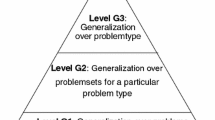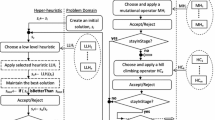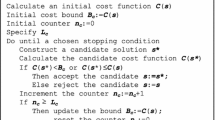Abstract
This paper presents a hybrid hyper-heuristic approach based on estimation distribution algorithms. The main motivation is to raise the level of generality for search methodologies. The objective of the hyper-heuristic is to produce solutions of acceptable quality for a number of optimisation problems. In this work, we demonstrate the generality through experimental results for different variants of exam timetabling problems. The hyper-heuristic represents an automated constructive method that searches for heuristic choices from a given set of low-level heuristics based only on non-domain-specific knowledge. The high-level search methodology is based on a simple estimation distribution algorithm. It is capable of guiding the search to select appropriate heuristics in different problem solving situations. The probability distribution of low-level heuristics at different stages of solution construction can be used to measure their effectiveness and possibly help to facilitate more intelligent hyper-heuristic search methods.



Similar content being viewed by others
References
Ahmadi S, Barrone P, Cheng P, Burke E K, Cowling P, Mccollum B (2003) Perturbation based variable neighbourhood search in heuristic space for examination timetabling problem. In Proceedings of multidisciplinary international scheduling: Theory and applications (MISTA 2003), pp 155–171
Asmuni H, Burke EK, Garibaldi JM (2005) Fuzzy multiple ordering criteria for examination timetabling. In: Burke E K, Trick M (eds) Practice and theory of automated timetabling V:selected papers from the 5th international conference on the practice and theory of automated timetabling (PATAT 2004), lecture notes in computer science, vol 3616 , pp 147–160
Asmuni H, Burke E K, Garibaldi J M, Mccollum B (2007) Determining rules in fuzzy multiple heuristic orderings for constructing examination timetables. In proceedings of the 3rd multidisciplinary international scheduling: theory and applications conference (MISTA 2007), pp 59–66
Asmuni H, Burke EK, Garibaldi JM, Mccollum B, Parkes A J (2009) An investigation of fuzzy multiple heuristic orderings in the construction of university examination timetables. Comput Oper Res Elsevier 36(4):981–1001
Battiti R, Protasi M (2001) Reactive local search for the maximum clique problem. Algorithmica 29 (4):610–637. Implementation from http://intelligent-optimization.org/
Biligan B, Ozcan E, Korkmaz EE (2007) An experimental study on hyper-heuristics and exam timetabling. In: Burke E K, Rudova H (eds) Practice and theory of automated timetabling VI: selected papers from the 6th international conference on the practice and theory of automated timetabling (PATAT 2006), lecture notes in computer science, vol 3867, pp 394–412
Burke EK, Bykov Y (2008) A late acceptance strategy in hill-climbing for examination timetabling problems. In proceedings of practice and theory of automated timetabling (PATAT 2008)
Burke EK, Eckersley AJ, Mccollum B, Petrovic S, Qu R (2010) Hybrid variable neighbourhood approaches to university exam timetabling. Eur J Oper Res 206:46–53
Burke EK, Hyde M, Kendall G, Ochoa G, Ozcan E, Qu R (2013) Hyper-heuristics:a survey of the state of the art. J Oper Res Soc 64:1695–1724
Burke E K, Kendall, G (eds) (2005), Search methodologies: introductory tutorial in optimization and decision support techniques. Springer
Burke EK, Petrovic S, Qu R (2006) Case based heuristic selection for timetabling problems. J Sched 9:115–132
Burke EK, Qu R (2009) Hybridisations within a graph based hyper-heuristic framework for university timetabling problems. J Oper Res Soc 60:1273–1285
Burke EK, Mccollum B, Meisels A, Petrovic S, Qu R (2007) A graph-based hyperheuristic for educational timetabling problems. Eur J Oper Res 176:177–192
Burke EK, Pham N, Qu R, Yellen J (2011) Linear Combinations of heuristics for examination timetabling. Ann Oper Res 194(1):89–109. 2012
Caramia M, Dellolmo P, Italiano GF (2001). In: Naher S, Wagner D (eds) Algorithm engineering 4th international workshop,proceedings WAE 2000.Lecture notes in computer science, vol 1982, pp 230–241
Carter MW, Laporte G, Lee T (1996) Examination timetabling: algorithmic strategies and applications. J Oper Res Soc 47:373–383
Cowling P, Kendall G, Soubeiga E (2000) In: Burke E K, Erben W (eds) A Hyper-heuristic Approach to Scheduling a Sales Summit, LNCS 2079, PATAT III, Konstanz, Germany, selected papers, pp 176–190
Culberson JC (1992) Iterated greedy graph coloring and the difficult landscape. Technical report [1992-07], Dept. Comp. Sci., Univ. Alberta, Canada
De Werra D (1985) An introduction to timetabling. Eur J Oper Res 19:151–162
Garey MR, Johnson DS (1979) Computers and intractability: a guide to the theory of NP-Completeness. W. H. Freeman
Glover F, Kochenberger G (eds) (2003) Handbook of metaheuristics. Kluwer Academic Publishers
Li J, Burke E K, Qu R (2012) A pattern recognition based intelligent search method and two assignment problem case studies. Appl Intell 36(2):442–453
Mccollum B, Schaerf A, Paechter B, Mcmullan P, Lewis R, Parkes A J, Di Gaspero L, Qu R, Burke E K (2010) Setting the research agenda in automated timetabling competition. INFORMS J Comput 120–130
Mühlenbein H (1996) From recombination of genes to the estimation of distributions I. binary parameters. In: Eiben A, Bäck T, Shoenauer M, Schwefel H (eds) Parallel problem solving from nature—PPSN IV, pp 178–187
Ozcan E, Misir M, Ochoa G, Burke E K (2010) A reinforcement learning – great-deluge hyper-heuristic for examination timetabling. Int J Appl Metaheuristic Comput 1(1):39–59
Pillay N, Banzhaf W (2007) A genetic programming approach to the generation of hyper-heuristics for the uncapacitated examination timetabling problem. In: Neves et al (eds) Progress in artificial intelligence.Lecture notes in artificial intelligence, vol 4874, pp 223–234
Pillay N, BanzhaF W (2009) A study of heuristic combinations for hyper-heuristic systems for the uncapacitated examination timetabling problem.European journal of operational research (EJOR), pp 482–491
Pillay N (2009) Evolving hyper-heuristics for the uncapacitated examination timetabling problem. In proceedings of the 4 th multidisciplinary international scheduling conference: theory and applications (MISTA 2009), pp 447–457
Qu R., Burke EK (2009) Hybridisations within a graph based hyper-heuristic framework for university timetabling problems. J Oper Res Soc 60:1273–1285
Qu R, Burke EK, Mccollum B (2009a) Adaptive automated construction of hybrid heuristics for exam timetabling and graph colouring problems. European J Oper Res 198(2):392–404
Qu R, Burke EK, Mccollum B, Merlot LTG, Lee S Y (2009b) A survey of search methodologies and automated approaches for examination timetabling. J Sched 12(1):55–89
Ross P, Marín-blazquez JG, Hart E (2004) applied to class and exam timetabling problems. In Proceedings of the 2004 IEEE congress on evolutionary computation. IEEE Press, Portland, pp 1691–1698
Sabar N R, Ayob M, Qu R, Kendall G (2012) A graph coloring constructive hyper-heuristic for examination timetabling problems. Appl Int 37(1):1–11
Soghier A, Qu R (2013) Adaptive selection of heuristics for assigning time slots and rooms in exam timetables. Appl Int 39(2):438–450
Terashima-marín H , Ross P, Valenzuela-rendón M (1999) Evolution of constraint satisfaction strategies in examination timetabling. In Genetic and Evolutionary Computation Conference (GECCO 1999), pp 635–642
Author information
Authors and Affiliations
Corresponding author
Appendix – The Carter Benchmark Dataset
Appendix – The Carter Benchmark Dataset
The Carter examination timetabling benchmark dataset [16] (details available at http://www.cs.nott.ac.uk/~rxq/data.htm) is one of the most widely tested sets in timetabling research community. Since its introduction in 1996, it has attracted much research effort from the community. During the years, researchers are reporting the best results obtained along with the development of advanced algorithms. This dataset still remains an interesting challenge as optimal solutions for all instances have not been found yet. Therefore, we evaluate our method on this dataset to compare results against many other existing methodologies. Table A-1 shows characteristics of the instances.
Two versions of the dataset have been circulated under the same name over the last ten years. We used the naming convention provided in [31]. An extensive survey is also provided in [31] on all search methodologies with associated best reported results for this dataset.
The hard constraint requires that any two exams having common students must be assigned to two different timeslots. The soft constraint concerns the spread of exams for students. If two exams are assigned into two timeslots t i and t j , then each student taking both of these exams will cause a penaltyof: 2 5−|i−j| if 0< |i – j | ≤5. The objective is to minimise the soft constraint penalty cost: total_penalty / number_of_students. This objective represents a preference to timetables where fewer students have to take exams too close to each other.
Rights and permissions
About this article
Cite this article
Qu, R., Pham, N., Bai, R. et al. Hybridising heuristics within an estimation distribution algorithm for examination timetabling. Appl Intell 42, 679–693 (2015). https://doi.org/10.1007/s10489-014-0615-0
Published:
Issue Date:
DOI: https://doi.org/10.1007/s10489-014-0615-0




